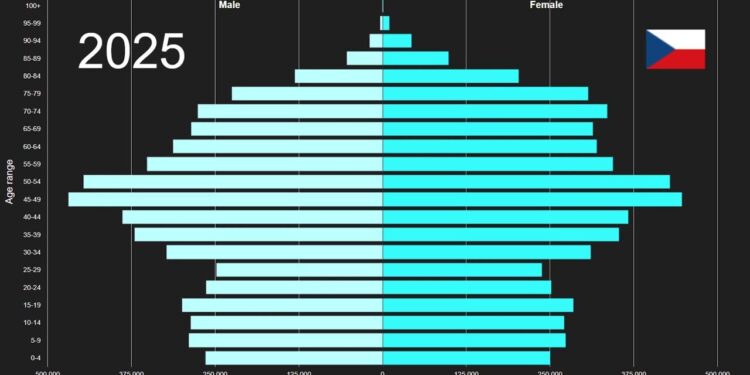The Czech Republic has witnessed a significant population decline in 2024, with official figures revealing a decrease of 27,200 people this year. According to recent data reported by Brno Daily, this demographic shift marks a notable development amid ongoing concerns about the country’s birth rates, migration patterns, and aging population. Experts warn that the downward trend could have wide-ranging implications for the nation’s economy, social services, and future workforce.
Czech Republic Faces Significant Population Decline Impacting Regional Growth
The Czech Republic is confronting a pronounced demographic downturn this year, with the population shrinking by approximately 27,200 people. This decline, driven by a combination of lower birth rates, increased mortality, and emigration, poses fresh challenges for regional economies striving to maintain growth momentum. Urban hubs like Brno and Ostrava are already witnessing shifts in labor markets and housing demands, signaling potential long-term impacts on investment and public services.
Experts warn that without targeted policy interventions, the demographic shifts could exacerbate existing inequalities across regions. Key areas affected include:
- Workforce availability: Reduced labor pools threaten productivity and innovation potential.
- Healthcare system: An aging population puts pressure on medical services and social care.
- Education sector: Declining youth numbers affect school enrollments and future skill development.
| Region | Population Change | Projected GDP Impact |
|---|---|---|
| South Moravia | -7,400 | -1.2% |
| Moravian-Silesian | -5,800 | -0.9% |
| Central Bohemia | -4,200 | -0.6% |
| Prague | -3,100 | -0.4% |
Demographic Shifts Affecting Workforce and Public Services Across the Nation
The recent decline in the Czech population by 27,200 individuals has triggered significant ripple effects across the workforce and public services nationwide. Employers are increasingly confronted with a shrinking labor pool, creating challenges in meeting the demands of various industries, especially in manufacturing and healthcare. This demographic contraction underscores an urgent need for policies that address workforce shortages while encouraging higher participation rates among underrepresented groups, such as women and older workers.
Public services, especially education and social welfare programs, are recalibrating resource allocation to adapt to these shifting demographics. Rural areas, which are experiencing more pronounced depopulation, face closures of local schools and reduced healthcare accessibility. Meanwhile, urban centers grapple with sustaining efficient infrastructure amidst a changing population dynamic. Key impacts include:
- Decreased demand for early childhood education services.
- Expansion of elder care facilities to accommodate an aging population.
- Pressure on pension systems due to a higher ratio of retirees to active workers.
| Region | Population Change | Main Workforce Impact |
|---|---|---|
| Prague | -5,000 | Skilled labor shortage |
| Moravia | -9,800 | Increased retiree dependency |
| Bohemia | -12,400 | Rural service closures |
Strategies to Address Population Loss and Promote Sustainable Development
To counteract the ongoing population decline, policymakers and local authorities are prioritizing a multi-faceted approach that balances economic revitalization with social support systems. Investing in family-friendly policies, such as increased parental leave and affordable childcare, aims to alleviate the financial burden on young families and encourage higher birth rates. At the same time, improving job opportunities in emerging industries and digital sectors across both urban and rural areas seeks to retain talent within the country rather than losing it to emigration.
Efforts also focus on sustainable development goals that foster long-term community resilience. Key strategies include:
- Enhancing public transportation networks to connect smaller towns with economic hubs
- Expanding access to quality education and vocational training tailored to future labor market demands
- Promoting green infrastructure projects to create environmental and employment benefits simultaneously
- Strengthening integration programs for immigrants to support demographic diversity and economic vitality
| Strategy | Expected Impact | Timeframe |
|---|---|---|
| Family-friendly policies | Increase birth rate by 10% | 3-5 years |
| Job creation in digital sectors | Reduce youth emigration | 2-4 years |
| Green infrastructure | Boost local employment by 7% | 4-6 years |
In Conclusion
As the Czech Republic confronts this significant population decline, policymakers and experts will need to analyze the underlying causes and consider strategies to address the demographic challenges ahead. The ongoing shifts in population dynamics may have profound implications for the nation’s economy, social services, and regional development. Brno Daily will continue to monitor this evolving situation and provide updates on efforts to stabilize and grow the country’s population in the coming months.
















